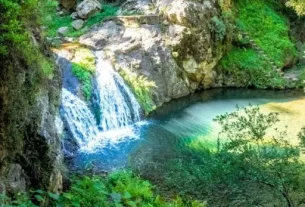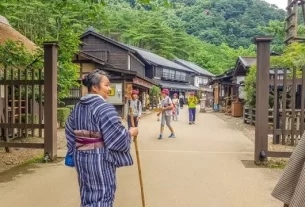Thinking about getting off the beaten path in Japan? Somewhere you might not have considered yet is Ojika Island or Ojikajima in Japanese. It’s a remote island getaway where you’ll find turquoise waters and stunning beaches but there is so much more to discover here.

This article is in collaboration with Ojika Town and Voyapon, more information on Ojika can be found on their website. Photo’s of Ojika in this article were taken by Todd Fong.
Table of Contents
Where is Ojika Island?
Ojika is an island off the coast of Nagasaki on the southern island of Kyushu. It’s located a little north of the Goto Islands and part of the Saikai National Park. The park is a marine paradise made up of 400 small volcanic islands with stunning landscapes and abundant sea life in the East China Sea.
How do you get to Ojika Island?
You can reach Ojika Island by ferry or speed boat from Kyushu Island. The trip takes 90 minutes by speed boat from Sasebo or 3 hours by ferry.
Another option is the 5-hour ferry directly from Fukuoka. You can get to Fukuoka by bullet train from across Japan arriving into Hakata station then taking the bus or taxi around 4 km to the port.
Cycling around Ojika Island
You can hire a car on Ojika Island as long as you hold an international drivers permit but for those who like a bit more activity and adventure in your travel then renting a bicycle for a few days is the way to go.
The island is around 25 km2 and according to the Tourism Office who rent the bikes on the island, you could cycle right around in a day. This is a laid back place, the roads and laneways are narrow and quiet making it ideal for those who want to see the sights at a relaxed pace. To give you a bit of perspective there are only 2 traffic lights on the whole island.

If you are at all concerned about navigating the undulating hills by pedal power alone, then consider hiring one of the electric cycles from the Tourism Office. Try to pick up the walking and cycling map while you are here, it marks the key sites and shows where facilities like bathrooms are available near the various attractions.
Map of sites on and around Ojika Island
A paper map will help you once you arrive but I’ve marked the main sites on a Google map for planning purposes. It will help you get a feel for the layout.
A unique food experience
Ojika Island a model for the locavore food movement with abundant farmland, ocean and community spirit. It has a history and culture that dates back thousands of years and at the same time is embracing small scale tourism and welcoming visitors to experience their culture and way of life.
It might be a small island but don’t rush to any conclusions, Fujimatsu Restaurant was recently mentioned in the regions Michelin Guide. It specialises in fresh local ingredients selected daily by the chef and the centrepiece will always be the seafood.

There are two sushi restaurants on the island, Sushi Heiroku is located across from the Ojika Fishing Cooperative so they always have a good selection of local favourites like uni (sea urchin) when it’s in season, delicate white fish, tuna and squid but they also offer more familiar options such as salmon which aren’t caught locally.
If you are out sightseeing for the day you might want to watch out for the local food truck called Flourjams. It moves around the island but the Tourism Office should be able to tell you where it’s parking while you are there. They serve more international fusion-style dishes like Taco and Cuban rice with sides of salads but their sandwiches made with bread from the local Ojika bakery are pretty popular too. Eat your choice at the tables near the truck or take it with you and cycle to a scenic spot nearby to enjoy it.
You might also have the option to join your hosts for a meal at your accommodation on the island or cook food that you caught or purchased during the day.
Things to do on Ojika Island
Slow down and explore
One of the main reason for seeking out destinations off the beaten path is to slow down to relax, interact with the locals and take in the sights. To do this walking or cycling are perfect. A cycle lets you cover more ground and at the same time you can pull off and ‘park’ almost anywhere.

Wander through narrow laneways in the old town, cycle beside rice paddies and find a beach all to yourself.
Watch the sunrise
Sunrise is one of the most peaceful times of the day and watching it come up over the water with the sound of the waves lapping on the shore is hard to beat. If you get up early you can cycle from town to one of the nearby beaches to enjoy the early morning colour in the sky.
Fish with the locals
The islands self-sufficient food culture is heavily dependent on the bounty of the ocean and many of the locals fish. Some of the accommodation options offer the chance to try this out for yourself and your catch is then prepared as part of the evening meal.

A popular catch is horse mackerel called aji in Japanese, it can be prepared simply and served raw as sashimi or coated in panko crumb and pan-fried. It’s caught on a line with multiple little hooks attached and a small basket at the bottom where you load the bait. The bait floats up around the hooks attracting the fish nearby.
Head to the beach
You are on an island so you’ll definitely want to head to the beach at some point. The most popular is Kakinohama Beach which is generally a calm and sheltered swimming beach for families. There are facilities here including changing rooms, toilets and wooden decks to sit on. You can snorkel out to a coral reef from the beach and it’s where you can rent watersports equipment in summer.

Not far from Kakinohoma Beach at the base of Goryo Cliff is another small beach. It’s surrounded by lava rock and can completely disappear during high tide but has the same stunning green and blue hues in the water. The beach is less sheltered here so it can be a bit rougher and is less popular with the locals so it can be a very peaceful option.
Another beach you will want to visit for its dramatic cliffs that drop to the ocean below is Akahama Beach. The colours in the sand vary depending on weather conditions and whether or not the sand is wet, so sometimes it appears brilliantly red and other times more like a muddy reddish-brown. The sand texture is different too, it’s coarser than the other island beaches, less ground down by the sea.
Take a sunset tour
You can head out on your own to the various vantage points or take a tour offered by some of the accommodation hosts on the island.
Many spots with a westerly aspect will be a good choice for viewing the sunset particularly if they look out over the water and have a wide horizon. Madara Island is the most popular spot but on a small island like Ojika, there are many other spots that also offer good westerly water views.
Head over to Madara Island
Madara is an island even smaller that Ojika that is just off the west coast, so close that it is connected by a bridge so you can drive or cycle across. Being to the west this is the best sunset spot and we’ve marked on the map above one of the best vantage points to view it from.

Another site seeing spot to include while you are over on Madara is ‘the Pothole’ or Giants Cauldron. This hole in the rock is a natural coastal phenomenon carved out by erosion over 1000’s of years. The location has had significance to locals for a long time signified by the old white torii gate that stands just beyond it but do be careful out here when the weather is rough, it can be dangerous.
Take a trip to Nozaki Island
Also part of the Ojika group and only a 30-minute boat trip from the port is the small island of Nozaki. There is a local ferry called Hamayu that makes 2 return trips over to the island daily as long as the weather permits. You’ll need to take food and water across with you and be prepared to hike around the island.
Today Nozaki island has been reclaimed by the forest and is home to wild deer, boars and many birds.
Where to stay on Ojika Island
Ojika offers a range of accommodations but if it’s in your budget the best way to really experience the island is to stay in a renovated kominka. These are large traditional homes on the island that have been restored and renovated.
One example is Ichiean. You’ll recognise the traditional elements of the design as soon as you enter. The tatami matting on the floor, sliding wooden doors, paper screens and the tokonoma similar to what you might see in a tea room is decorated with scrolls, flowers and beautiful utensils. The garden beyond the windows is an extension of the room when the wide doors are open.

A counterbalance to the beautifully restored traditions is a large television, a fully-equipped electric kitchen and a modern western bathroom. You can pick up local ingredients during the day and prepare your own fresh meal here in the evening.

Another kominka is Yanoya. The long restoration of this one was done by the Hasegawa’s using traditional materials and techniques. The couple now runs the property as 3 private guest rooms where meals are shared together.
The Hasegawa’s speak a little English so it’s an opportunity to interact with locals in a relaxed atmosphere or head out with them to learn the local way of fishing.
Who would enjoy a stay out here?
Ojika Island is going to really appeal to those who enjoy slow travel, who like to immerse themselves in a place, explore slowly and interact with the locals. If rugged scenery, nature, serenity and fresh delicious food appeal then you’ll want to consider Ojika Island.
Japans history and culture is fascinating and you will find more than you expected out here. Artifacts have been recovered on the island that date back over 10,000 years of civilisation and Shinto Shrines such as Kojima have a history of over 1300 years.
If you found this article useful please consider saving it to Pinterest. It makes it easy for you to find it again, it helps us, and it helps other travellers to find the information they are looking for.



